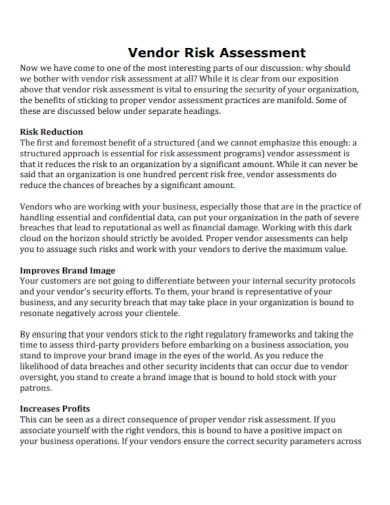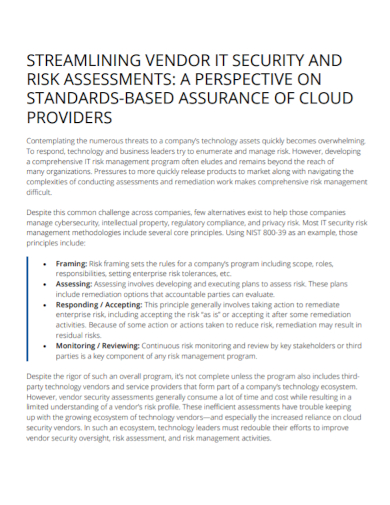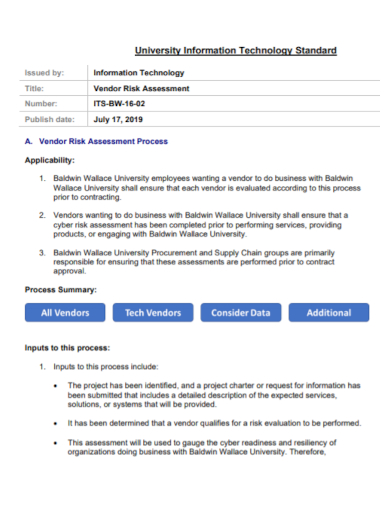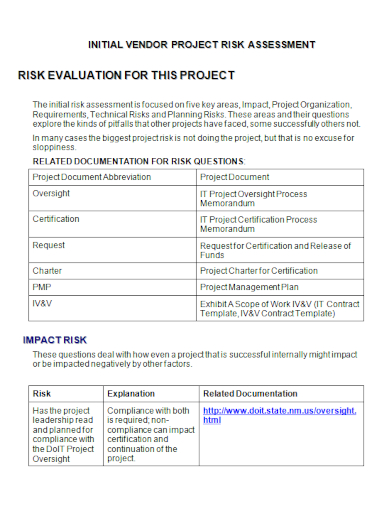A business organization cannot operate without a partner supplier or better known as vendors. They play a major part in helping business by providing goods and services to the organization. Vendors are important contributors to the business cycle. Maintaining a good relationship is a two way benefit for both parties as this can help with own revenues and productivity. Yet, even having vendor partners has its own risk, so it is important that before choosing the right vendors or even as you have started a business deal with them it is best to keep them on track. To help get you started, we have vendor risk assessment samples below. Please check it out!
6+ Vendor Risk Assessment Samples
1. Vendor Risk Assessment Form
2. Vendor Risk Assessment
3. Sample Vendor Risk Assessment
4. Vendor Security Risk Assessment
5. Security Office Vendor Risk Assessment
6. Information Technology Vendor Risk Assessment
7. Vendor Project Risk Assessment
What Is a Vendor Risk Assessment?
Another term for this is third-party risk assessment or vendor risk review is the process of identifying and assessing potential risk or hazards as a company collaborate with a vendor’s product or services. This can be beneficial as these can help companies choose or monitor their business partners as so not to put their own business into jeopardy. It can be a long and tedious process but the rewards are there. Careful assessment can also lead to better understanding your suppliers and what measures should be taken. Before conducting a risk assessment, know your vendors first. Here are some examples:
Third Party with Various Skills and Backgrounds: These could be web developers, IT professionals, lawyers, analysist, customer service, healthcare professionals and many more. They may not be staff but the provide service and their expertise to the company.
Contractors: Examples are architects, electricians, plumbers, carpenters, bricklayers, painters, hair stylists, wedding planners, auto mechanics and etc. They may hold short term or long term contracts, but nonetheless they still hold the same standards when it comes to risk management.
Manufacturers and Suppliers: Usually they provide materials or tangible products to a company.
Service Providers: These vendors are internet and telephone service providers, janitorial services, consultants and banks.
There are still more out there, but this is to give a basic idea of the third party transaction a company deals with in a daily basis.
How to Conduct a Vendor Risk Assessment?
There are lot’s of areas to be tackled when conducting a third party risk assessment since access and other types of secure information may be different for the role a vendor plays. To give an overview, here are some key points to consider:
I. Identify Your Vendor
First and foremost know who you are dealing with. It can be risky to go into a business deal with third party services without careful assessment. Determine the potential risk they pose and what information should be disclosed to them. This is not only limited as the company is in a search for new suppliers but for existing vendors as well. Narrow down your list and segregate each one as to the type of service or product they offer or basically what is their role as business partners. After narrowing it down, it’s time to identify each potential risk they can impose to the business organization.
II. Risk Type and Criteria
As you have narrowed down you list of vendors, identifying the risk type and criteria is the next step to this process. Once again this will depend on the on what type of business your organization conducts and what the vendor does. There are several risk that stem from third-party vendors, this can be Data Privacy Risk, Operational and Transaction Risk, IT Disruption and fraud or theft. With these you can analyze each potential risk your vendors may impose and its implications on the business.
III. Assessment of Product and Services
Aside from just assessing the vendor as a company, take time to look into their products and services. Check on the advantages and disadvantages they may pose and look into all angles. A thorough evaluation can help your company decide if its worth starting or continuing a business with.
IV. Risk Management Plan
After assessing a vendor, it is time for the management to create a risk management plan. These are projects that are prepared by managers to address the risk and hazards, the potential impact it has on the business and define responses to reduces these risks.
V. Law and Regulations
With various risk and hazards on the rise affecting any type of business there a laws and regulations that help counter them. Staying up to date and making sure your company policies are align with these. Ensure that not only your company is complaint but your vendors as well.
VI. Annual Assessment
Vendor risk management should not be a one time thing but should be conducted annually to see to it that vendors still adhere to the rules and policies. Also, there could be sudden changes in services and products which means they need to go through another round of evaluation.
FAQs
What Is a Vendor Document List?
These are a documents that contains information regarding construction team plans to build elements of the project. They are shop drawings, material and product data and samples. Then these are submitted for review and approval.
What Is a Risk Management Team?
A group of people who are separate and often independent unit within the project management team headed by the risk manager or the chief risk officer. They are the workforce that institute the risk assessment procedure and risk action plan.
What Does a Chief Risk Officer Do?
An executive who is responsible for identifying, analyzing, and mitigating internal and external risks in a company.
It is impossible to say that operating a business could be done without any risk. This does not only happen within employees and management but with third-party vendors as well. Careful evaluation and assessment is needed to keep the partnership running smoothly. This is not because a company completely mistrusts their vendors, but this is to build a stronger bond and safe relationship with them.
Related Posts
FREE 10+ Contractor Health and Safety Questionnaire Samples
FREE 9+ HACCP Hazard Analysis Templates
FREE 9+ Sample Safety Statement
FREE 9+ Hazard Vulnerability Analysis Templates
FREE 8+ Risk Management Job Description Samples
FREE 6+ Product Liability Checklist Samples
FREE 6+ Bow Tie Risk Analysis Samples
FREE 13+ Security Incident Response Plan Samples
FREE 12+ Health and Safety Policy Templates
FREE 10+ Ansoff Matrix Samples
FREE 9+ Sample IT Security Policy
Things Every Project Manager Should Know
FREE 9+ Sample IT Project Manager Job Description
FREE 9+ Sample Privacy Policy Samples
FREE 9+ Market Research Report Samples







